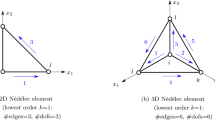Abstract
We employ classical Maxwell’s equations formulated in space-time algebra to perform discretization of moving geometries directly in space-time. All the derivations are carried out without any non-relativistic assumptions, thus the application area of the scheme is not restricted to low velocities. The 4D mesh construction is based on a 3D mesh stemming from a conventional 3D mesh generator. The movement of the system is encoded in the 4D mesh geometry, enabling an easy extension of well-known 3D approaches to the space-time setting. As a research example, we study a manifestation of Sagnac’s effect in a rotating ring resonator. In case of constant rotation, the space-time approach enhances the efficiency of the scheme, as the material matrices are constant for every time step, without abandoning the relativistic framework.
Similar content being viewed by others
References
Auchmann, B., Kurz, S.: Observers and splitting structures in relativistic electrodynamics. J. Phys. A Math. Theor. 47(43), 435202 (2014)
Bossavit, A.: Computational Electromagnetism. Academic Press, San Diego (1998)
Bossavit, A.: “Generalized Finite Differences” in computational electromagnetics. PIER 32, 45–64 (2001)
Codecasa, L., Specogna, R., Trevisan, F.: Symmetric positive-definite constitutive matrices for discrete eddy-current problems. IEEE Trans. Magn. 43(2), 510–515 (2007)
Codecasa, L., Trevisan, F.: Piecewise uniform bases and energetic approach for discrete constitutive matrices in electromagnetic problems. Int. J. Numer. Methods Eng. 65(4), 548–565 (2006)
Doran, C., Lasenby, A.: Geometric Algebra for Physicists, 2nd edn. Cambridge University Press, Cambridge (2003)
Fecko, M.: Differential Geometry and Lie Groups for Physicists. Cambridge Books Online. Cambridge University Press, Cambridge (2006)
Hehl, F.W.: History related Maxwell’s equations in Minkowski’s world: their premetric generalization and the electromagnetic energy-momentum tensor. Annalen der Physik 17(9–10), 691–704 (2008)
Hestenes, D.: Space-Time Algebra. Documents on Modern Physics. Gordon and Breach, New York (1966)
Hestenes, D.: Differential Forms in Geometric Calculus. In: Brackx, F., Delanghe, R., Serras, H. (eds.) Clifford Algebras and Their Applications in Mathematical Physics, pp. 269–285. Springer, Berlin (1993)
Hestenes, D.: The shape of differential geometry in geometric calculus. In: Dorst, L., Lasenby, J. (eds.) Guide to Geometric Algebra in Practice, pp. 393–410. Springer, Berlin (2011)
Hestenes, D., Sobczyk, G.: Clifford Algebra to Geometric Calculus: A Unified Language for Mathematics and Physics. D. Reidel; Distributed in the USA and Canada by Kluwer Academic Publishers, Dordrecht; Boston; Hingham (1984)
Hiptmair, R.: Finite elements in computational electromagnetism. Acta Numerica 11, 237–339 (2002)
Jin, J.-M.: The Finite Element Method in Electromagnetics. Wiley, New York (2002)
Klimek, M., Roemer, U., Schoeps, S., Weiland, T.: Space-Time Discretization of Maxwell’s Equations in the Setting of Geometric Algebra. In: 2013 International Symposium on Electromagnetic Theory, editor, IEEE Xplore (2013)
Mattiussi, C.: The geometry of time-stepping. Prog. Electromagn. Res. 32, 123–149 (2001)
Misner, C.W., Thorne, K.S., Wheeler, J.A.: Gravitation. W.H. Freeman and Company, New York (1973)
Mur, G.: Absorbing boundary conditions for the finite-difference approximation of the time-domain electromagnetic-field equations. IEEE Trans. Electromagn. Compat. EMC 23(4), 377–382 (1981)
Novitski, R., Scheuer, J., Steinberg, B.Z.: Unconditionally stable finite-difference time-domain methods for modeling the Sagnac effect. Phys. Rev. E 87, 023303 (2013)
Peng, C., Hui, R., Luo, X., Li, Z., Xu, A.: Finite-difference time-domain algorithm for modeling Sagnac effect in rotating optical elements. Opt. Express 16(8), 5227–5240 (2008)
Salamon, J., Moody, J., Leok M.: Geometric representations of whitney forms and their generalization to Minkowski spacetime. arXiv:1402.7109v1 (2014)
Schuhmann, R., Weiland, T.: A stable interpolation technique for FDTD on nonorthogonal grids. Int. J. Numer. Model. Electron. Netw. Devices Fields 11(6), 299–306 (1998)
Sobczyk, G.: Simplicial calculus with geometric algebra. In: Micali, A., Boudet, R., Helmstetter, J. (eds.) Clifford Algebras and Their Applications in Mathematical Physics, pp. 279–292. Springer, Berlin (2011)
Steinberg, B.Z., Shamir, A., Boag, A.: Two-dimensional Green’s function theory for the electrodynamics of a rotating medium. Phys. Rev. E 74, 016608 (2006)
Stern, A., Tong, Y., Desbrun, M., Marsden, J.E.: Geometric computational electrodynamics with variational integrators and discrete differential forms. arXiv:0707.4470 [v2] (2009)
Weiland, T.: Time domain electromagnetic field computation with finite difference methods. Int. J. Numer. Model. 9, 295–319 (1996)
Yang, Y., Pesavento, M.: A unified successive pseudoconvex approximation framework. IEEE. Trans. Sig Process. 65(13), 3313–3328 (2017). https://doi.org/10.1109/TSP.2017.2684748
Author information
Authors and Affiliations
Corresponding author
Additional information
Communicated by Bertfried Fauser
Rights and permissions
About this article
Cite this article
Klimek, M., Kurz, S., Schöps, S. et al. Discretization of Maxwell’s Equations for Non-inertial Observers Using Space-Time Algebra. Adv. Appl. Clifford Algebras 28, 22 (2018). https://doi.org/10.1007/s00006-018-0841-3
Received:
Accepted:
Published:
DOI: https://doi.org/10.1007/s00006-018-0841-3




